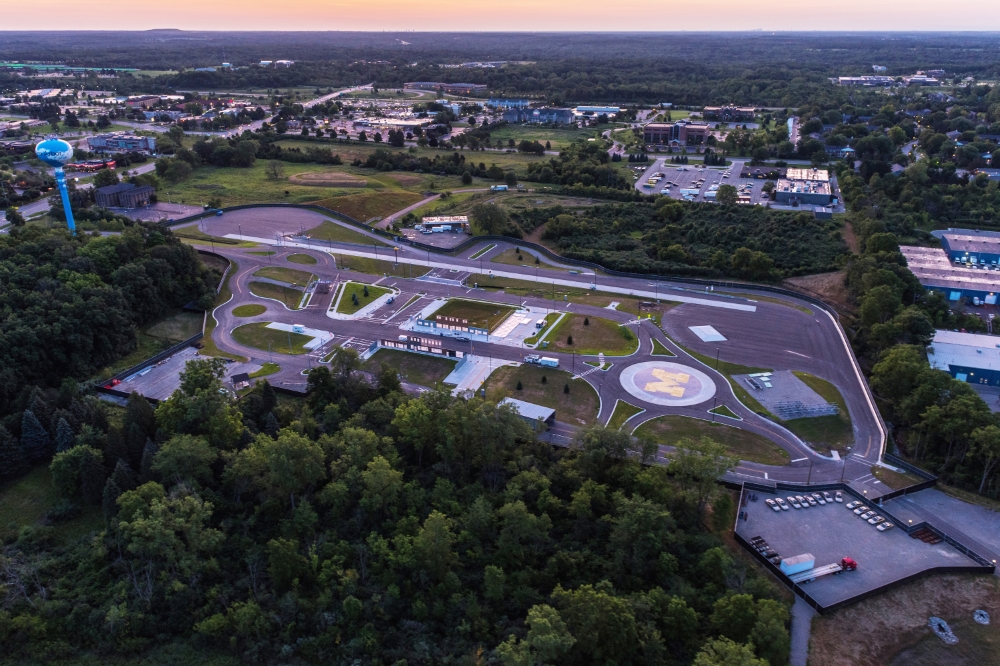Michigan IS mobility.
The Great Lakes State not only gave rise to the Model A and the Model T, but also laid the groundwork for automotive manufacturing as we know it. Companies that choose to operate in Michigan become part of a rich tradition and legacy, joining an ecosystem of competitive advantages in the global auto industry.
From end-to-end supply chains and various international partners to a pro-business state government, Michigan presents automotive companies with a compelling case for expansion. Beyond building cars, Michigan has the infrastructure, technology, and talent to keep the wheels of global mobility turning.
Look back over the past decade of corporate facility investments in the automotive space, and you’ll find Michigan right where you’d expect: out in front. Its leadership is visible in the data, reflecting a commitment to growth and innovation.

Michigan Central Innovation District is expected to create 5,000 jobs and generate $370 million in tax revenue over the next 35 years
Photo courtesy of MEDC
Michigan’s global dominance in the automotive sector by the numbers:
- The state’s 325 projects in the sector (as tracked by Site Selection Magazine’s proprietary database) account for nearly 12% of the national total since January 2015 and mirror the state’s leadership in overall automotive investment. The next closest total is in industry neighbor Ohio, around 30 projects behind, with Texas trailing by another 20 projects.
- According to SelectUSA’s cluster mapping tool, the state’s employment in the sector — 178,092 as of February 2025 — tops the charts. And Michigan is home to no fewer than 937 automotive establishments, No. 1 in the country, due in part to generations of investment and reinvestment.
- Metro Detroit and the entire state adopt technology quickly because Michiganders are the ones inventing it and then taking it out for a spin. According to the Startup Genome 2023 Global Startup Ecosystem Report, Detroit ranks as one of the world’s top three emerging startup ecosystems, with the highest individual ecosystem value at $103 billion. Michigan also boasts more than 60% of the country’s total mobility and electrification R&D spending, and Michigan’s total business R&D spending-to-GDP ratio is 1.5 times the national average.
- In the 2024 URC Benchmark Findings report, the schools in Michigan’s University Research Corridor, now the Research Universities for Michigan, spent $2.7 billion in R&D and maintained a national top 10 ranking.
The bottom line? Michigan is where mobility experts and large-scale automotive innovators go to perfect their craft. This drive to excel is baked into the DNA of Michigan and its workforce, and the global leadership position of Michigan in this field is unmatched.
That is also why entrepreneurs love Michigan. According to the PatentsView data tool created by Periscope and partners for the U.S. Patent and Trademark Office, in 2024, Michigan was No. 6 in the nation by number of inventors (9,272), with nearly 700 more inventors with patents than No. 7 Illinois and about 1,200 more than No. 8 Pennsylvania. Sort the data by mechanical engineering, and Michigan vaults to No. 2 in the country behind only the massive nation-state of California. It turns out that more than one-third of Michigan’s inventors in 2024 (3,745 of them) achieved their patents in this technical field, within which the state has steadily climbed in accumulated inventions since the late 1970s.
An Electric Future
Building on its legacy as an automotive and manufacturing leader, Michigan is at the forefront of the latest in mobility innovation. The state is home to the world’s first-of-its-kind Connected and Automated Vehicle (CAV) Corridor on Interstate 94. The first public in-road, EV-charging wireless system is located at Michigan Central’s innovation district in Detroit, a new culture and tech hub created with a $740 million investment from Ford Motor Co. around the famous Michigan Central Station.
The hub burst onto the scene in 2024 after the train station had sat dormant for over 30 years. The 30-acre campus is expected to create 5,000 jobs and generate $370 million in tax revenue over the next 35 years. The MEDC’s support is part of a broader commitment by the state to align more than $126 million in investments, programming, and resources to support the goals of the district, all built around supporting startups and developing talent to build an ecosystem that welcomes collaborators, from Ford and Google to international companies like Germany-based EV charging station provider EcoG.
“While Michigan Central Station serves as the crown jewel, the expansive Michigan Central Innovation District exemplifies the Make It in Michigan vision, showcasing the state as a place for innovation and economic opportunity,” says a report by the MEDC. “This comprehensive strategy focuses not just on restoring buildings, but on cultivating talent, fostering innovation, and rebuilding communities.”
Michigan Central is also home to Newlab, a global venture platform that has partnered to build an ecosystem dedicated to shaping the future of mobility and is working to re-establish Detroit as a global leader in innovation.
The Newlab building at Michigan Central opened in April 2023 — a key piece in the 30-acre Michigan Central Innovation District — with an initial cohort of 25 startups. To date, Newlab at Michigan Central’s membership has grown to 106 member companies and about 675 individual members representing the mobility, transportation, logistics, and climate tech sectors. These startups come from all over Michigan, across the country, and around the world, choosing to help lead mobility innovation from Detroit.
Michigan Keeps Moving Forward
Say all you want about industry legacy and history. What Michigan’s all about today is moving forward with innovation.
In October 2024, the state’s Office of Future Mobility and Electrification (OFME) hosted the inaugural Michigan Mobility Conference at Newlab at Michigan Central, bringing together industry leaders to discuss how Michigan’s advancements in mobility are shaping the global landscape. The event marked OFME’s first official mobility conference and featured Gov. Gretchen Whitmer’s announcement of the Changing Lanes program, a statewide initiative to empower automotive professionals to transition into careers in the growing advanced mobility sector.
Gov. Whitmer also announced the new Michigander Scholars Program, launched by the MEDC and the Talent Action Team. The program offers scholarships to technology and engineering students at the University of Michigan, Michigan State University, Michigan Technological University, Wayne State University, and Kettering University. In addition to financial support, the program connects students with companies offering internships and career opportunities in mobility and technology.
Mobility research at the University of Michigan alone involves more than 120 researchers, an ecosystem that spawned 20 startups over 10 years, and funding totaling more than $601 million over the five years ending in 2023.
The forward momentum applies to all modes of mobility, including airspace.
In 2023, Michigan Central and the Michigan Department of Transportation (MDOT) created the Advanced Aerial Innovation Region (AAIR) program to accelerate commercial drone development and position Michigan as a leader in next-generation aerial mobility. Funding comes through the Advanced Aerial Mobility (AAM) Activation Fund, a collaborative effort among MDOT, OFME, and the MEDC.

MCity, the University of Michigan’s hub for autonomous testing, in October 2024 kicked off its remote program, allowing researchers in autonomous and connected vehicle technologies from around the U.S. to be remote users of its physical and virtual testing environment
Photo courtesy of the University of Michigan
Michigan Central will scale digital and physical infrastructure to expand the capabilities of AAIR, says the MEDC, and launch a series of pilots in partnership with Newlab across use cases, including building inspection for energy efficiency, middle-mile movement of goods between manufacturing facilities, and movement of critical supplies on hospital campuses aimed at generating techno-economic data to accelerate the adoption of beyond visual line of sight (BVLOS) UAS operations.
Among the successful projects to (literally) launch is an aerial drone from Blueflite with a light attached to test on-demand illumination for pedestrians at night. Another is a project from Mythos AI and Newlab to create autonomous hydrography to revolutionize maritime shipping with a pilot project at Michigan’s Port of Monroe. This project will map marine highways while simultaneously training algorithms for self-driving in-shore vessels.
In July 2024, Michigan Lt. Gov. Garlin Gilchrist II announced that four projects will receive $6.25 million in total funding to scale critical AAM infrastructure and deploy pilot projects.
“Advanced air mobility is an incredible economic opportunity for the State of Michigan,” said Lt. Gov. Gilchrist II. Projects receiving the awards include the AAIR, unmanned aircraft system testing and scale-up in the Grand Traverse region via Traverse Connect, ship-to-shore drone delivery from Skyports at Great Lakes ports in Sault Ste. Marie and Detour Village, and $2.6 million to BETA Technologies to install multimodal chargers at Cherry Capital Airport, Capital Region International Airport, West Michigan Regional Airport, and Willow Run Airport to create a foundational intrastate charging network to support operations of next-generation aircraft and drive down costs for regional transportation operators.
“Michiganders have always been pioneers in the mobility space, and now we’re taking to the skies, finding new ways to use next-generation transportation to deliver critical resources like medical supplies and food, reinforcing international partnerships and cross-border collaboration, and so much more,” says Justine Johnson, Michigan’s Chief Mobility Officer.
IN OCTOBER 2024, THE DETROIT REGIONAL PARTNERSHIP SHARED A FEW REASONS WHY THE REGION AND THE ENTIRE STATE REMAIN ATTRACTIVE PLACES TO BE FOR MOBILITY:
- The state has the nation’s highest concentration of engineers.
- Twenty-six original equipment manufacturers (OEMs) are located in Michigan, as are 96 of the top 100 automotive suppliers, 60 of which have their North American headquarters in the state. Michigan’s automotive and mobility assets go much deeper than major automakers, reports MichAuto, the state’s auto and mobility industry advocate and a Detroit Regional Chamber affiliate.
- The $13.8 billion in automotive R&D spending in Michigan annually accounts for over 60% of the national total.
- With more than $28 billion in EV and battery-related investments announced from 2018-2023, Michigan is projected to have enough EV battery capacity to support more than 10 million EVs per year by 2030. The figure is expected to rise as new developments occur, such as LG’s $2.5 billion battery plant.

